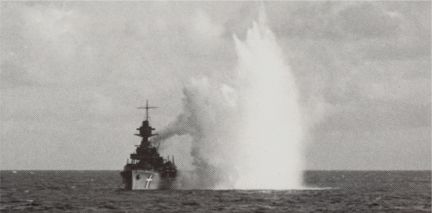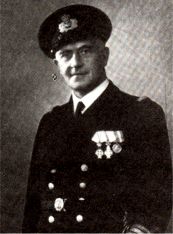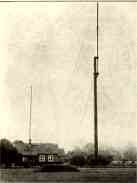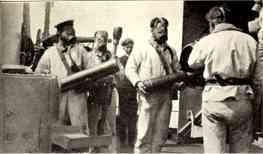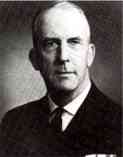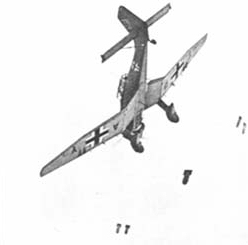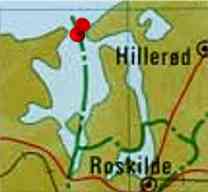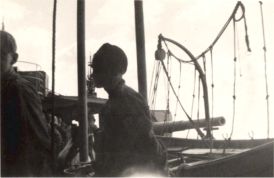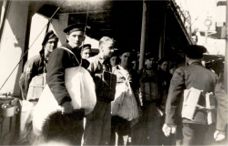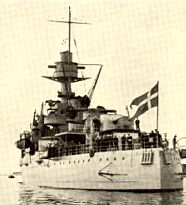|
You are here: 4Campaigns & Battles4Index4The 2nd World War4Attack on NIELS IUEL |
|||||||||||||||||||||||||||||||||||||||||||||||||||||||||||||||||||
|
The battle in Isefjorden (1943):
German bombs exploding close to the
NIELS
IUEL
The
coast defense ship
|
||||||||||||||||||||||||||||||||||||||||||||||||||||||||||||||||||
|
The 49 year old CO of the NIELS IUEL, Comman-der s.g. Carl Westermann, knew his ship well. He had previously served as captain and second in command of the ship, and had several years experience with the navy’s torpedo boats. But not only was he an experienced commander, he had also been a member of the Danish Parliament since 1933 and had earlier in the year of 1943 been elected First Deputy Chairman of the Parliament. In the days before the 29th of August 1943, the Danish government and public had send a clear signal that they would no longer accept the cooperation with the Germans, which had been the government’s responds to the occupation on the 9th of April 1940. It’s quite symbolic that the NIELS IUEL, during the fight against the Germans, was commanded by the first Deputy Chairman of the Danish Parliament. |
Carl Westermann, |
Increased tensions
During August 1943 the tensions between the German occupation forces and the Danish Government had grown considerably. The Danish defense forces had felt the rising tensions, and the fear of the German coup against the Danish armed forces had become clear to all.
Friday August 27th, the NIELS IUEL had received a message from the Naval Supreme Command with instructions to lie at short notice. At the same time, the ship was notified that the situation was to be regarded as an increased state of alert.
Saturday, August 28th, the captain of the NIELS IUEL received some information about what was going on in the rest of Denmark.
He afterwards held a meeting with the rest of the ships officers, and they decided to cancel all leave and maintain the ship on short notice.
Later that day, the CO informed the crew that the Danish government had rejected the German demands.
Operation Safari
Due to increasing public unrest, which had been growing during the month of August, and German dissatisfaction with the Danish government lacking ability or will to maintain order, the Germans began contemplating introducing emergency measures in Denmark.
The unrest and strikes had caused supply problems for the German forces, and this only made the situation more alarming for them.
|
Vice Admiral
A. H. Vedel, |
At the same time, the Germans wanted to disarm the Danish army and navy, which had been allowed a limited service following the German occupation of Denmark on April 9th, 1940. The Germans began planning an operation, which aimed to quell the unrest in Denmark and secure the Germans their needed supplies. The operation was codenamed SAFARI. While the German occupation forces were planning their move, the Danish vice-admiral Vedel had already, on the 30th of May 1943, informed his men, what to do if the Germans attacked. The aim of his order was to make sure that no Danish ships were taken by the Germans. The German operation was planned to begin at 0245 on August 29th. |
General Alarm – seek Swedish waters
|
At ten minutes after four in the morning August 29th, the NIELS IUEL received a radio message, which repeated the order to maintain the increa-sed state of alert, and only one minute later, the ship received another message – general alarm! The general alarm was sounded on the NIELS IUEL, and while the ship was preparing to leave Holbæk, the crew began readying the ship for action. At 0420 the ship received the message: "Seek Swedish waters". None of the three above mentioned radio mes-sages had been sent from the naval radio sta-tion at the Naval Dockyard, but came from a se-cret transmitter hidden somewhere in Copenha-gen. Delay caused by the weather |
The naval radio building |
Bad weather with lots of rain and a powerful northerly wind made it difficult for the NIELS IUEL to leave the harbor at Holbæk.
Not until around 0550 did the NIELS IUEL succeed in casting off, and it had to be assisted by the naval cutter P 37, a local tugboat and the ships own motorboat, before it cleared the harbor.
But the bad weather also delayed the German launching of Operation SAFARI.
The latest information
Commander Carl Westermann tried numerous times before the ship left harbor to gain information about what was happening in the rest of the country. He tried several times to contact the Royal Dockyard in Copenhagen by phone, but without success.
Not until right before the NIELS IUEL was about the leave Holbæk, did commander Westermann succeed in getting the news so desperately needed.
A police officer, who came aboard the ship right before it left the harbor, told Westermann that two nearby army barracks had been overrun by the Germans, and that rumors had it that the naval units in Copenhagen had been scuttled by their own crews.
He also informed Westermann that the police stations in Roskilde and Nykøbing Sj. had been occupied by the Germans.
Westermann, however, had no way of making sure that this information was correct.
Battle Stations
Aboard the NIELS IUEL the crew had begun preparing for battle almost as soon as the general alarm had been sounded. The covers on the guns had been removed, and the ammunition had been armed.
But the Germans were watching.
Even before the ship had left Holbæk, a German plane had sighted the ship and reported its precise location back to the German headquarters. The plane had also been spotted by the NIELS IUEL.
When the ship was reported as laying with full steam on its engines, and its crew milling around on the deck, the Germans knew that it was preparing to leave the harbor.
This prompted the Germans to keep a close eye on the ship as it moved up through the Isefjorden.
Everybody is ready for action
In spite of the sighting of the German planes, the morale onboard Niels Juel was excellent.
The crew spoke about the possibility of combat or how it was important that the ship was blown up, so it didn’t fall into German hands.
NIELS IUEL sailed full speed north in the fiord. The speed was approx. 14-15 knots, and the crew used the time to eat. But the crew at the guns mostly had their breakfast at their stations at the guns.
German ships and planes ahead!
When NIELS IUEL reached a point south of Lynæs Sand, close to the mouth of the Isefjorden into the Kattegat three German naval units were spotted from the ship. The German ships – one large and two smaller units - were at approx. ten miles from the NIELS IUEL.
|
Pre-war picture of the gun crew at the NIELS IUEL's 15 cm guns, wearing gas masks |
As the NIELS IUEL approa-ched the German units, these were identified as an auxiliary cruiser – probably a mine layer or a large mine sweeper - and two torpedo boats. The guns on the NIELS IUEL were made ready to fire – a move the crew applauded. Everybody aboard was ready to fight their way through if it proved necessary. At the same time the crew kept a wary eye on the |
German planes around the NIELS IUEL – Three to four bombers and two to three Stukas were in the air around the ship.
Minefields ahead!
When NIELS IUEL reached Hundested around 0830 in the morning, the ship received a signal from the harbor that the Germans had laid a minefield north of the fiord.
At the same time, the ship received word that it would receive new orders from the Naval Supreme Command.
The signal, however, did not dissuade the captain of the NIELS IUEL's from making an attempt to reach Swedish neutral waters.
Commander Carl Westermann’s original plan had been to let the NIELS IUEL sail close to land, north around Zeeland, in order to give the Germans the impression that his intentions were to make for the Royal Dockyard in Copenhagen. He would then in the last moment turn the ship toward Sweden and try to make it across the last miles of the sound.
The new information did not make Westermann change his plans.
Judging from the size of the German vessels, he did not think that the German minefield could have been placed close to land.
At the same time, he thought that the NIELS IUEL would stand a fair chance against the German sea and air forces.
The commander had, however, nothing to fear from the German minefields – they were still only on the drawing board.
The Germans had, as a part of Operation SAFARI, planned to place a minefield at the mouth from the Isefjorden with the sole purpose to keep the NIELS IUEL from breaking out, but the operation had been canceled on August 28th because of German problems with the preparing of the mines in Kiel.
Awaiting further orders
Westermann judged that the Germans had already shown all the forces they were planning to use to prevent NIELS IUEL attempt to break out of the fiord, and he therefore judged that a small delay wouldn’t make that much of a difference.
|
At the same time Westermann mentioned that he had in fact been ordered by the Naval Supreme Command that new orders from them should be obtained if or when the situation changed. Furthermore Westermann needed more information about the situation. Apart from the information he had received just before the ship left Holbæk, he had no viable information about what was happening in Denmark. Westermann therefore decided to wait for new orders from the Naval Supreme Command, before he made the attempt to break out. He therefore ordered the ship to reduce speed so that it would stay just outside Hundested. Commander S. Pontoppidan, the officer on duty at the Naval Supreme Command, was in the meantime on his way from Copenhagen to Hundested with the orders from the chief of the Danish Navy. |
Commander |
These orders, however, were dictated by the German admiral in Denmark.
The German planes attacks!
While NIELS IUEL were cruising slowly outside Hundested and awaiting further orders, the German decided to take action against the ship.
|
The feared German dive-bomber Ju87 "Stukas" participated in the attack on the NIELS IUEL. |
The German naval commander in Denmark had now received information from the German troops in Hundested. The Germans reported that the NIELS IUEL was leaving the fiord at high speed and with all guns manned. He therefore ordered the Luftwaffe to attack. The first attack came without much notice at 0855, when a Ju87 attacked the ship from starboard side. The plane fired its guns and dropped two bombs, which landed about 30 meter from the ship. Westermann got the impression that this attack was meant as a demonstration, and he therefore did not order his men to fire against the attacking plane. The explosions, however, were so powerful |
that the lights went out for several minutes aboard the NIELS IUEL.
The Danes opens fire
NIELS IUEL changed course and began sailing south. During the turn the German plane attacked again, but this time only with its guns.
But this time the AA-guns on the NIELS IUEL returned fire, and the German plane was hit in its right wing by the Danish fire.
Earlier in the day the radio station had been ordered to, as soon as the first shots were fired, start playing the National hymn on the ships loudspeakers. So when the ship opened fire that tunes from the song "Kong Christian" was heard all over the ship.
The captain of the ship ordered the AA-guns to cease fire and the gun crews were send below to seek shelter.
Following the second attack, the 1st artillery officer, Commander Arendrup, asked for permission to open fire at the German auxiliary cruiser. Commander Westermann denied the request because he did not believe that Denmark and Germany were at war.
The attacks continue
Between 0910 and 0920 the German planes attacked twice, but again only using their machineguns. During both attacks the ship was hit but without suffering any real damage.
|
The fighting took place outside Hundested |
At 0935 yet another air attack on the NIELS IUEL took place. This time the planes used both guns and bombs. Westermann judged that this attack was directed directly against the ship, and he ordered the AA-guns manned again. Two of the bombs exploded less than ten meters from the port side of the ship, and this made the ship heel violently. Eyewitnesses on land reported that it looked like the ship was lifted out of the water, and it was subsequently covered by so much water that only the ships stern was visible. |
The explosion was so powerful that the NIELS IUEL was seriously damaged. All power aboard – including the emergency backup – broke down and darkness ruled all over the ship. At the same time the ships fire control equipment was put out of service.
Unconfirmed reports from land told that at least one German aircraft crashed due to the AA-fire from the NIELS IUEL.
Five wounded men
During the last air attack, several crewmembers at the unprotected AA-guns had to dive for cover, in order to avoid being hit by shrapnel.
Five men were wounded by bomb-fragments and splinters from the wooden deck. One of the wounded, Artillery Quartermaster H. E. Andreasen, was hit in the stomach and died two days later.
The remaining four wounded were Decks Quartermaster V. V. Jørgensen, who was hit in the face by a bomb-fragment, plus three mariners; artillery apprentice J. Mortensen, the enlisted men Foldbjerg-Jeppesen and O. Petersen.
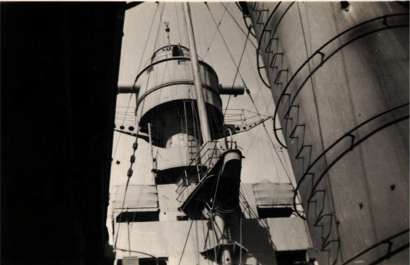
At the right you can find some of the bullet
holes in the funnel of
Niels IUEL
(Photo: From the private archives of Ove Nielsen)
In spite of this, the morale onboard the NIELS IUEL remained high even though the ship had suffered a lot of damage.
New orders
Following the last attack the NIELS IUEL resumed its southbound course. Outside Hundested the orlogskaptajn S. Pontoppidan came aboard, sailed out to the Niels Juel by the cutter K 7.
He brought new orders from the Naval Supreme Command's and vice-admiral Vedel for Westermann. These orders told the commander:
" – Due to German mines and the presence of strong German naval units at the mouth of the Isefjorden, the NIELS IUEL is to await further orders. August 29, 1943 at 0730. Vedel - "
Pontoppidan was able to tell Westermann, that Vedel had signed the order at the Hotel Phønix, which was the German naval headquarters in Copenhagen. This last piece of information decided Westermann's next move.
At 1030 orlogskaptajn Pontoppidan again left the NIELS IUEL.
Flank Speed
Commander Westermann realized that the chance of reaching Swedish waters was miniscule, especially now it was no longer dark.
The ship was already heavily damaged, and this combined with the risk of further German attacks from air and sea, meant that there was a great risk of heavy loss of men aboard the ship.
|
Westermann therefore decided to run his ship a ground and destroy as much of it as possible in order to render it unusable for the Germans. Looking at the map, Westermann was able to find a place nearby where it would both be possible to run the ship a ground, and at the same time would be difficult for the Germans to salvage the ship afterwards. He ordered all ahead full, and at 1048, with |
The artillery ship
NIELS IUEL a ground in Isefjorden |
approx. fifteen knots speed, the coast defense ship NIELS IUEL was run a ground just south of Nykøbing Sjælland.
A few minutes after the grounding the anchors was dropped and this let the German planes, circling the ship, to believe that the ship had followed the order and they therefore left the area.
God Save the King – destroy the ship
Right after the ship had run a ground, four of the wounded were brought ashore and brought to the nearby hospital in Nykøbing Sjælland.
At around 1100 an attempt was made to blow up the ship, but this failed when the detonators didn’t to go off.
|
|
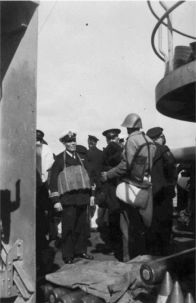 |
|
The crew wearing life life jackets
are mustered and getting ready to demolish |
|
The crew then began systematic destroying the ships equipment, and at the same time parts of the ship was flooded when the sea cocks were opened. The magazines were also flooded.
Live ammunition, the locks to the 15 cm guns, fire control- and navigation-equipment, small arms and a lot of other things were thrown overboard.
When this was completed the commander mustered the crew on the deck, where he briefly told them why he had chosen to beach the ship, and thanked the crew for its valiant conduct of its duty.
He ended his speech with a “God bless the King, God bless Denmark” – his speech was numerous times met by cheers from the crew and when he was finished the crew spontaneously began singing the national hymn.
Striking the Naval Ensign
The next morning, at around 0520, two German torpedo boats ran alongside the NIELS IUEL, and heavily armed German soldiers came aboard and took control of the ship.
|
On the 30th of August the crew was mustered for the last time and the Danish Naval Ensign were stricken |
At the same time the captain of the NIELS IUEL received a note from the German naval chief, which informed him that he in case of sabotage would be tried by a German military court, and that the penalty for such actions was death. The crew of the NIELS IUEL was disarmed, but the officers were allowed to keep their swords. At 0700 the crew was mustered for the last time on the aft deck on the ship. The German troops kept back while commander Westermann held a brief speech to the crew. After this the Naval Ensign was stricken. At the same time the naval cutter P 37, which was lying next to the NIELS IUEL, also struck its colors. |
After this the crew was taken ashore and later interned at Sjællands Odde and in Copenhagen.
Not build to withstand aerial attacks
The German attack showed clearly how difficult it was to hit a comparatively small ship like the NIELS IUEL, but at the same time, the powerful explosions revealed a number of weaknesses in the ships construction.
The keel for the NIELS IUEL was laid down in 1914. At that time nobody had the foresight to imagine that a ship could be attacked by aircrafts. But NIELS IUEL was more or less made disabled by the two air attacks, even though no bombs hit the ship.
The bombs, which exploded close to the ship, caused the electricity to break down, and this disabled both the primary and secondary fire control system.
The shakings from the explosions started the engines on the ships two torpedoes in their tubes. The engines seized up and the crew feared that the torpedoes would explode.
The sides of the ship were pressed in and the bridge and superstructure was heavily damaged.
|
Sources: |
||
|
& |
Da Danmarks Flaade blev sænket, by F. H. Kjølsen, Commander s.g., H. Hagerups Forlag, Copenhagen, 1945 |
|
|
& |
Danmarks Flaade, by Lieutenant Commander K. Dahl, published by Selskabet til udgivelse af Kulturskrifter, Copenhagen, 1934 |
|
|
& |
Flåden den 29. august 1943, by Jørgen H. P. Barfod, published by Orlogsmuseet, Copenhagen, 1993 (ISBN 87-87720-10-8) |
|
|
& |
Operation Safari 29. august 1943, by Knud Hendriksen, published by Det Kongelige Garnisonsbibliotek, Copenhagen 1993 (ISBN 87-984624-0-7) |
|
|
& |
Vedrørende NIELS JUEL's forsøg på udbrud fra Isefjorden søndag den 29. august 1943, article in HJEMMEVÆRNET no. 10/1967 |
|
|
44You are also referred to the Naval Bibliography |
||
![]()
- Do you miss a major event on this Site,
or do you hold a great story?
Are you able to contribute to the unfolding of
the Danish Naval History,
please
e-mail
me, enclosures are welcome.
Please remember to list your sources.
You can also use the Naval Web Forum on this web-site.
![]()
|
MORE IN-DEPTH STORIES FROM |
|
Scuttling the Navy -
The attack on
the - -
Attack on |
|
THE TOPIC STORIES: |
|
- Wars against England (1801-1814) - Reconstructing the Navy (1814-1848) - The 1st Schleswig War (1848-50) - The interim War Years (1850-64) - The 2nd Schleswig War (1864) - The long Period of Peace (1864-1914) - The Navy during the 1st World War (1914-1918) - The Interim Years (1919-1939) - The Navy during the 2nd World War (1939-1945) - The Cold War Period (1945-1989) - |
|
SEE THE PHOTO GALLERIES: |
-
This page was last updated: -
This page was first published: October 20, 2002
Copyright © 2013-2016 Johnny E. Balsved - All rights reserved - Privacy Policy

